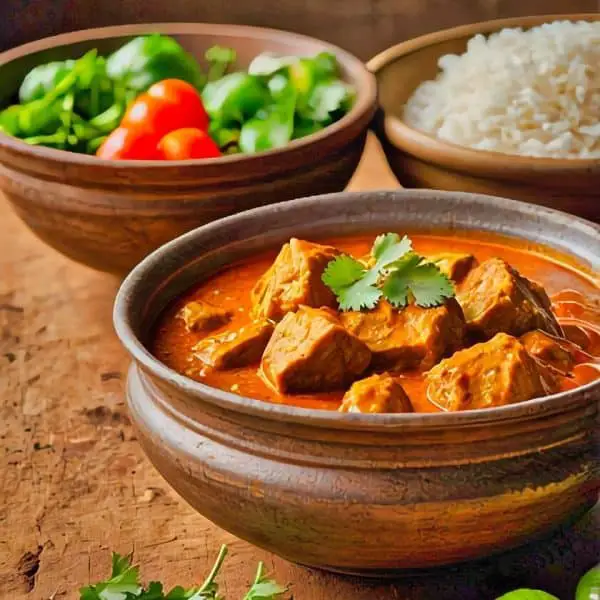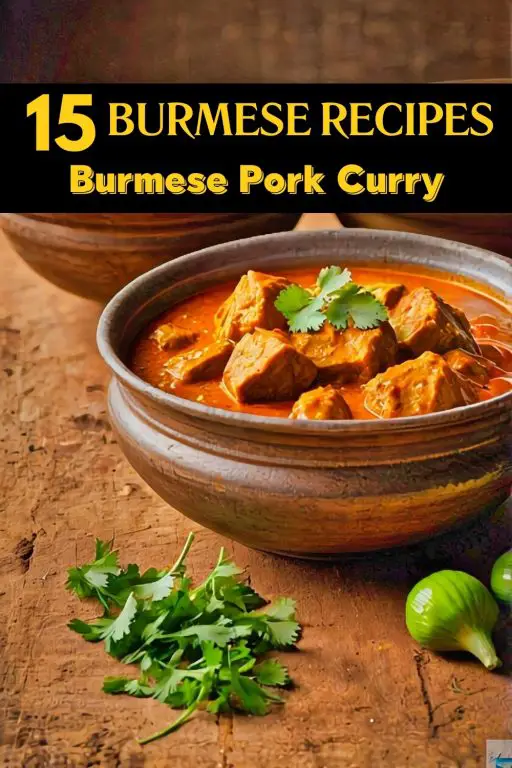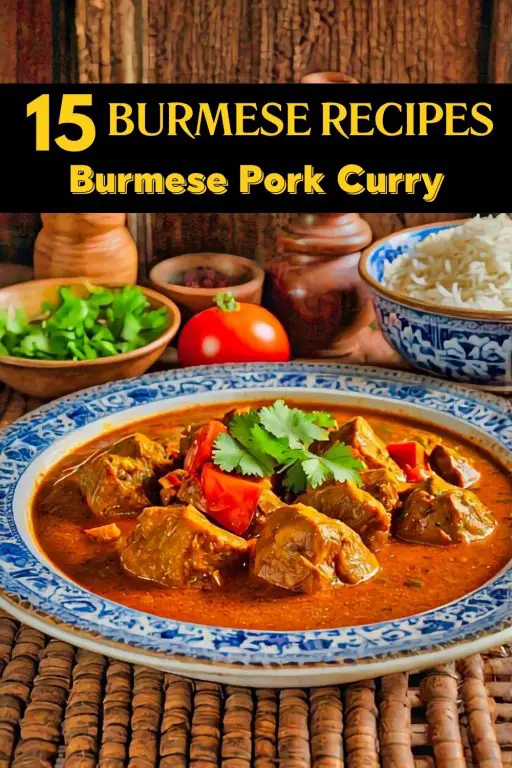Burmese Pork Curry is a dish that is known for its rich, slow-cooked taste. We made it in a cooking class. I learned that this curry tastes different in different parts of Myanmar as we cooked it. The Burmese Pork Curry recipe in the north of the country is usually spicier because it uses more local spices. In the south, on the other hand, the recipe is usually softer so that the natural flavors of the pork can stand out more.
While I was making the Burmese Pork Curry dish, I found it interesting that it stressed slow cooking. This way is used all over the world because it keeps the pork tender while letting the flavors develop fully. However, some places, especially those close to the coast, might add a bit of sourness with tamarind or other local ingredients. Inland places, on the other hand, keep the food simple and stronger with spices.
It was clear by the end of the class that the Burmese Pork Curry recipe isn’t a one-size-fits-all dish. Because it uses spices and varies by area, it can be changed to fit local tastes and ingredients. The dish is made in different ways in different parts of Myanmar, but the basic idea is always the same: a slow-cooked curry with lots of flavors that brings out the natural flavor of the pork. It made me more aware of how food can be different based on where you are after I tried the dish and learned how to make it.
Ingredients For the Burmese Pork Curry
Boneless Pork Shoulder
Vegetable Oil
Chopped Onion
Minced cloves garlic
Peeled and Grated Fresh Ginger
Yellow Curry Powder
Ground Coriander
Ground Cumin
Paprika
Turmeric
Salt
Cayenne Pepper
Chicken or Vegetable Broth
Coconut Milk
Fish Sauce
Tamarind Paste
Brown Sugar
Sliced Red Chilies
Cooking Instructions For the Burmese Pork Curry
- In a large pot or Dutch oven, heat the vegetable oil over medium-high heat. Add the onion and cook until softened, about 5 minutes.
- Add the garlic and ginger and cook for another minute.
- Add the curry powder, coriander, cumin, paprika, turmeric, salt, and cayenne pepper, and stir until fragrant, about 1 minute.
- Add the pork and stir to coat in the spice mixture.
- Pour in the broth, coconut milk, fish sauce, tamarind paste, and brown sugar. Bring to a simmer and reduce heat to low.
- Cover and cook for 1 to 1 1/2 hours, or until the pork is tender and the sauce has thickened.
- Serve over steamed rice and garnish with sliced red chilies (optional).
Food Most Eaten by Locals in Burma
In Burma, now officially known as Myanmar, the diet is deeply influenced by its rich cultural heritage and regional diversity. The Burmese diet is predominantly based on rice, which is the staple food, complemented by a variety of dishes that reflect the country’s diverse agricultural products and culinary traditions.
Rice is central to Burmese meals, served with a wide array of accompanying dishes. These side dishes, often referred to as “curry” or “thoke,” are essential to the Burmese dining experience. One of the most popular is Mohinga, a fish-based noodle soup considered the national dish. It features rice noodles in a broth made from fish, lemongrass, and a blend of spices, typically garnished with crispy fritters, boiled eggs, and fresh herbs. This dish showcases the Burmese preference for combining rice with aromatic and flavorful ingredients.
Another staple is Laphet, fermented tea leaves mixed with various ingredients such as nuts, seeds, and dried shrimp. This dish is often eaten as a salad or side, offering a unique taste profile with its tangy, slightly bitter flavour. Laphet reflects the Burmese love for pickled and fermented foods, which are common in many local diets.
Shan Noodles are another popular choice, originating from the Shan State in eastern Myanmar. This dish consists of rice noodles served with a spicy, savoury sauce made from tomatoes, garlic, and sometimes minced pork or chicken. It highlights the regional diversity in Burmese cuisine, with variations across different states and ethnic groups.
Vegetables and legumes also play a significant role in the Burmese diet. Kaukswe, a noodle dish cooked in coconut milk and accompanied by a mix of vegetables and sometimes chicken or pork, is a common meal. The use of coconut milk and a variety of fresh vegetables highlights the country’s abundant agricultural produce.
Burmese salads (known as “thoke”) come in various types, such as Tangy Green Papaya Salad and Chickpea Salad, and are typically made with fresh, local ingredients. These salads are usually tangy and spicy, with ingredients like lime juice, fish sauce, and chili peppers.
Meals are often accompanied by peyet (rice wine) or tea, reflecting the local drinking culture. In rural areas, traditional meals are more simple and rely heavily on local produce, while urban areas may offer more variety due to the influence of international cuisines and the availability of diverse ingredients.
Overall, the Burmese diet is a reflection of its rich cultural tapestry, combining rice with a variety of vegetables, meats, and unique regional flavors.
5 Essiential Ingredients for Cooking Burmese Style Food
1. Rice
Description: Rice is the fundamental staple of Burmese cuisine, reflecting its status as a primary food source across Myanmar. It is typically long-grain or jasmine rice, known for its slightly sticky texture when cooked.
Usage: Rice accompanies nearly every meal, serving as the base for curries, soups, and salads. It is essential in dishes like Mohinga, where it is sometimes added directly to the soup or served on the side. In addition to steamed rice, fried rice variations are also popular, often including vegetables, meats, and sometimes even seafood. Rice is versatile, used in both everyday meals and festive dishes.
2. Fish Sauce (Ngan Pya Yay)
Description: Fish sauce is a fermented condiment made from fish and salt. It has a pungent aroma but imparts a deep umami flavour that is crucial to many Burmese dishes. It is usually made from anchovies or other small fish and aged to develop its robust taste.
Usage: Fish sauce is used extensively to season soups, curries, and salads. In dishes like Laphet (fermented tea leaf salad), it adds a salty depth that balances the tangy and bitter notes of the tea leaves. It is also a key ingredient in many dipping sauces and marinades, contributing to the complex flavour profiles typical of Burmese cuisine.
3. Lemongrass
Description: Lemongrass is a fragrant herb with a citrusy, slightly floral flavour. Its stalks are used in cooking, providing a bright, fresh aroma and taste. In Burmese cuisine, it is used both for its flavour and for its fragrant qualities.
Usage: Lemongrass is commonly added to broths and soups, such as Mohinga, to impart a distinctive lemony taste. It is also used in marinades for meat and fish, and in curries to enhance the overall flavour profile. Lemongrass is typically cut into pieces or bruised to release its essential oils, infusing dishes with its aromatic essence.
4. Ginger
Description: Ginger is a spicy, aromatic root widely used in Burmese cooking. It adds warmth and depth to dishes, with a flavour that is both sharp and sweet. Fresh ginger is preferred, though dried or powdered ginger is also used in some recipes.
Usage: Fresh ginger is often combined with garlic to form a flavour base for many Burmese dishes. It is used in curries, soups like Kaukswe (coconut noodle soup), and stir-fries. Ginger’s warming spice complements the complex flavours of Burmese cuisine, balancing out richer elements and enhancing the overall taste.
5. Turmeric
Description: Turmeric is a bright yellow spice known for its earthy, slightly bitter flavour and vibrant colour. It contains curcumin, which is responsible for its distinctive hue and is celebrated for its health benefits.
Usage: Turmeric is integral in many Burmese curries and stews, where it imparts a rich golden colour and an earthy flavour. It is often used in combination with other spices to create the complex flavour profiles typical of Burmese curries. Turmeric is also used in rice dishes and some soups to add both colour and flavour. Its presence is key to achieving the characteristic appearance and taste of traditional Burmese dishes.
Each of these ingredients plays a crucial role in defining the unique flavours of Burmese cuisine, contributing to the rich and varied taste experiences that characterise Myanmar’s culinary traditions.
FAQ For the Burmese Pork Curry
Q: What cuts of pork work best for a Burmese Pork Curry recipe?
A: In a traditional Burmese Pork Curry recipe, pork shoulder or belly is ideal due to its balance of fat and meat, which adds richness and flavor. These cuts become tender during the slow cooking process, absorbing the spices and broth. The fat also helps to thicken the curry sauce, making it more luscious. Leaner cuts like pork loin can be used but may result in a drier texture if overcooked.
Q: What spices are essential for a flavorful Burmese Pork Curry recipe?
A: A Burmese Pork Curry recipe typically relies on a blend of turmeric, chili powder, cumin, and coriander to create its distinctive flavor profile. Fresh ginger, garlic, and onions are also key components, adding depth to the curry. Some variations might include lemongrass or fish sauce for added complexity. These spices and aromatics combine to create a rich, savory dish with just the right amount of heat.
Q: Can a Burmese Pork Curry recipe be cooked in a slow cooker?
A: Yes, a Burmese Pork Curry recipe can be easily adapted for a slow cooker, allowing the pork to become tender and flavorful over time. Simply prepare the curry paste by sautéing the spices and aromatics before adding them to the slow cooker with the pork. Set it on low for 6-8 hours or on high for 4-5 hours, depending on the cut of pork used. The slow cooking method enhances the flavors, making the dish even more aromatic.
Q: How can I adjust the spice level in a Burmese Pork Curry recipe?
A: The spice level in a Burmese Pork Curry recipe can be adjusted by increasing or decreasing the amount of chili powder or fresh chilies used. To make the dish milder, reduce the chilies and balance the flavor with additional coconut milk or tomatoes. For more heat, add extra chili or top the dish with spicy condiments like chili oil or fried chili flakes. This flexibility makes it easy to tailor the dish to your personal spice tolerance.
Q: What sides pair well with a Burmese Pork Curry recipe?
A: A Burmese Pork Curry recipe is best served with steamed jasmine rice or sticky rice, which helps balance the rich, spicy flavors. Some prefer to pair it with naan or flatbreads to scoop up the curry sauce. Fresh sides like cucumber salad or pickled vegetables offer a cooling contrast to the richness of the pork. These combinations create a well-rounded meal that highlights the bold flavors of the curry.

Burmese Pork Curry
Equipment
- Large pot or Dutch oven
- Cutting board & Chef's knife
- Measuring cups and spoons
- v
Ingredients
- 2 lbs. boneless pork shoulder, cut into 1-inch pieces
- 2 tbsp vegetable oil
- 1 large onion, chopped
- 3 cloves garlic, minced
- 1 inch piece fresh ginger, peeled and grated
- 2 tbsp yellow curry powder
- 1 tbsp ground coriander
- 1 tbsp ground cumin
- 1 tbsp paprika
- 1 tbsp turmeric
- 1 tsp salt
- ¼ tsp cayenne pepper
- 2 cups chicken or vegetable broth
- 1 14 oz can coconut milk
- 2 tbsp fish sauce
- 1 tbsp tamarind paste
- 1 tbsp brown sugar
- 2 red chilies, sliced (optional)
Instructions
- In a large pot or Dutch oven, heat the vegetable oil over medium-high heat. Add the onion and cook until softened, about 5 minutes.
- Add the garlic and ginger and cook for another minute.
- Add the curry powder, coriander, cumin, paprika, turmeric, salt, and cayenne pepper, and stir until fragrant, about 1 minute.
- Add the pork and stir to coat in the spice mixture.
- Pour in the broth, coconut milk, fish sauce, tamarind paste, and brown sugar. Bring to a simmer and reduce heat to low.
- Cover and cook for 1 to 1 1/2 hours, or until the pork is tender and the sauce has thickened.
- Serve over steamed rice and garnish with sliced red chilies (optional).





3 comments
The pork curry texture and taste were spot-on—definitely a keeper!
I cant believe they didnt mention the importance of marinating the pork overnight for maximum flavor! That step is crucial for a truly authentic Burmese Pork Curry. Who else agrees?
I cant believe they left out the crucial step of marinating the pork overnight! Thats what gives it that amazing flavor! Who else agrees? Lets not skip this step next time!
Comments are closed.